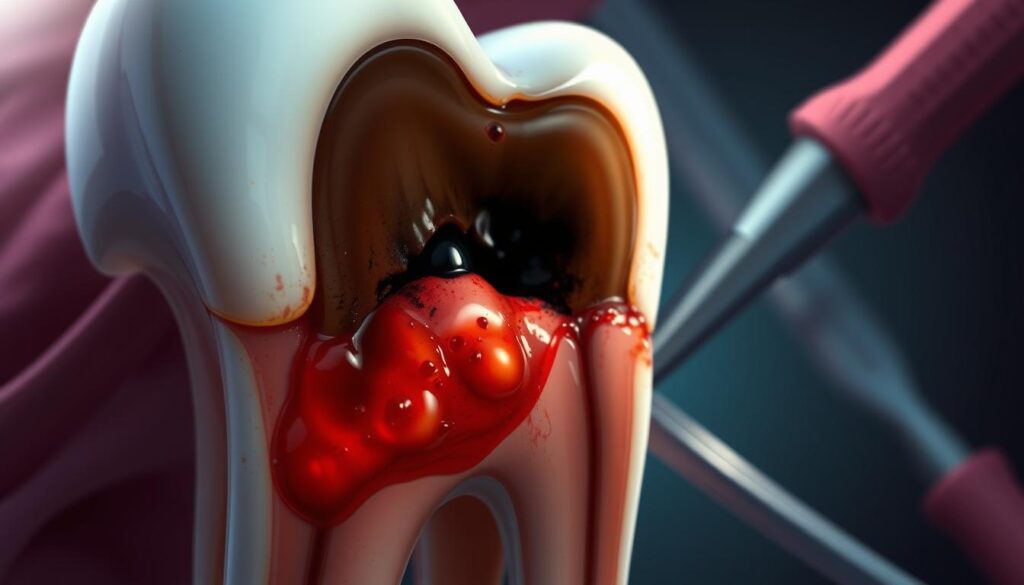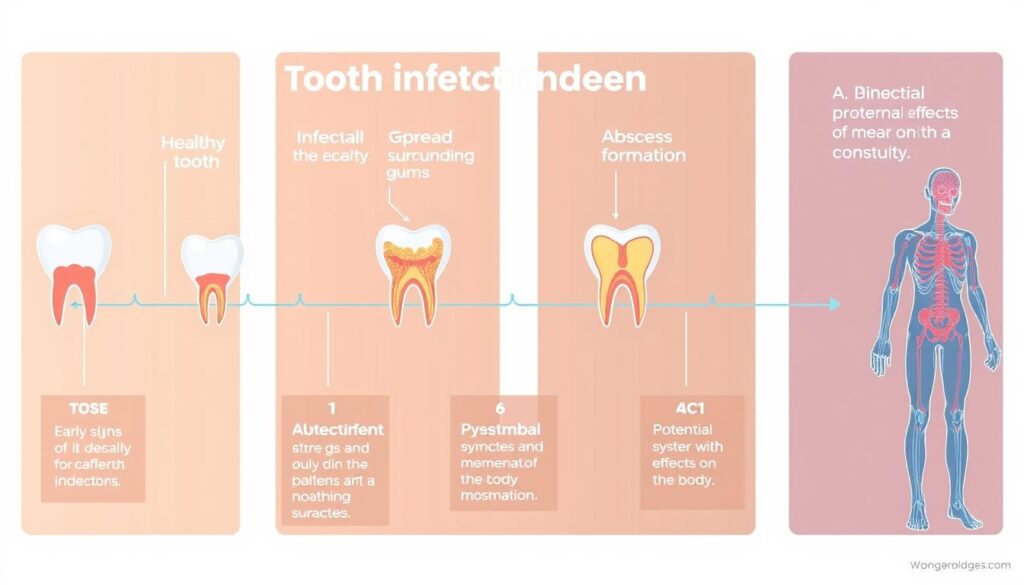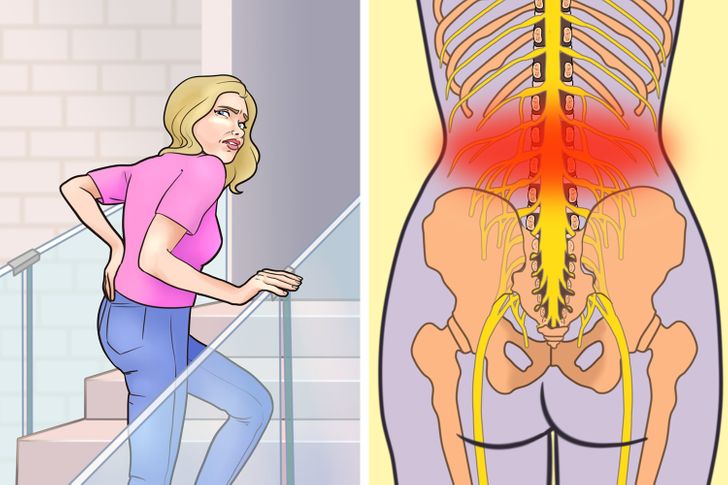Tooth infections were once a major killer before modern dentistry. Now, they are rare causes of death. But, they can still be deadly if not treated. The time it takes for a tooth infection to be fatal depends on how fast it spreads and if it reaches vital organs.
Dentists stress the need for quick action if you think you have a tooth infection. Knowing the types, symptoms, and how they progress is key to staying safe.
Understanding Tooth Infections and Their Severity
Tooth infections can get worse fast if not treated. They happen when bacteria get into the soft tissue inside a tooth. This usually happens because of tooth decay or injury. Knowing about dental abscesses and their signs is key to stopping them before they get worse.
Types of Dental Abscesses
There are three main types of dental abscesses. Periapical abscesses happen when bacteria get into the dental pulp. This causes swelling and inflammation at the root’s tip. Periodontal abscesses occur in the gum tissue around the tooth. Gingival abscesses are infections in the gum itself.
Signs and Symptoms of Tooth Infection
Symptoms of a tooth infection include sharp pain and sensitivity to hot and cold. You might also see swelling and a bitter taste in your mouth. Sometimes, the tooth can become loose, and you might have fever, tender lymph nodes, and trouble opening your mouth.
Initial Warning Signs
Early signs of a tooth infection include a persistent toothache and red gums. You might also notice your tooth becoming loose. Don’t ignore these signs. Quick treatment is needed to stop the infection from spreading and getting worse.
“Tooth infections, if left untreated, can potentially lead to serious complications such as the spread of infection to other body parts, possibly resulting in conditions like sepsis, which can be life-threatening.”

Can a Tooth Abscess Be Fatal?
In developed countries, life-threatening tooth infections are rare. But, if not treated, they can be deadly. Before 1908, 10-40% of tooth infections were fatal. Now, thanks to modern dental care and antibiotics, the risk is much lower.
However, if an infection reaches the heart or brain, it can cause serious problems. These include sepsis, necrotizing fasciitis, or brain abscesses. These are life-threatening complications.
Tooth infections can turn into painful abscesses if not treated. They can spread to the mouth, jawbone, and bloodstream. Signs of sepsis include fever, rapid breathing, and confusion.
A tooth infection can also reach the brain. This causes severe headaches, fever, and confusion.
Neglected tooth infections can lead to serious conditions like Ludwig’s angina. This can block airways and make breathing hard. But, thanks to modern medicine, death from tooth infections is now rare.
Antibiotics for tooth infections usually last 7-10 days. Mouthwashes like Listerine help keep the mouth clean. But, they don’t cure the infection.
“In the 17th and 18th centuries, dental infections were one of the top causes of death.”
A dental abscess from tooth decay can take months to develop. But, an abscess from a tooth injury can progress faster. If left untreated, a toothache can last for months.
Once a serious complication from a tooth infection occurs, death can happen quickly. It can even occur within days.

Dental infections often take months to show symptoms. These include red gums, throbbing pain, and bad taste. Other signs are bad breath, tooth discoloration, and sensitive teeth.
Severe symptoms that need immediate medical attention include fever and swollen lymph nodes. Also, malaise, swelling around the face, and trouble breathing. Other signs are nausea, vomiting, and persistent headache.
The Timeline of Tooth Infection Progression
Tooth infections can get worse and even life-threatening if not treated. It’s important to know how fast a tooth infection can spread. This helps in getting medical help quickly and avoiding serious problems.
Early Stage Development
Tooth infections often start with tooth decay. The enamel wears down, and decay reaches the tooth’s inner pulp. This can happen faster if the tooth is injured.
Once the pulp gets infected, an abscess can form. This can last for weeks or months before someone gets emergency care.
Advanced Infection Phases
The infection can spread to other parts of the body as it gets worse. Untreated abscesses can cause serious symptoms in just a few days or weeks, especially if you have a weak immune system.
Critical Point Indicators
Without quick treatment, sepsis from a tooth infection can be deadly, with a 30% mortality rate. In severe cases, this can jump to a 50% mortality rate. Risks include health problems, poor dental care, and a weak immune system.

“Dental infections left untreated can quickly turn into a dental emergency, potentially affecting major organs in the body.”
How Long Until a Tooth Infection Kills You
The time it takes for a tooth infection to be fatal can vary a lot. It might take weeks or months for a simple infection to become deadly. But, ignoring a dental abscess can lead to serious problems.
Tooth infections are more common in certain groups, such as older adults and those with chipped teeth. Poor oral hygiene also raises the risk. Dentists categorize these infections into three types: periodontal, gingival, and periapical.
When a tooth infection gets serious, it can cause big problems. Sepsis, a body-wide reaction, can lead to organ failure and death. Infections that spread to the brain or neck can also be deadly, causing strokes or blocked airways.
“Dental infections can progress rapidly and become fatal if left untreated. Seeking prompt medical attention at the first signs of a tooth infection is crucial to prevent serious complications.”
But, thanks to modern dentistry, deaths from tooth infections are rare. Regular dental visits and early treatment can stop infections from getting worse. This might include draining abscesses, antibiotics, or root canals.
To keep your mouth healthy and avoid deadly infections, brush twice a day with fluoride toothpaste. Clean between your teeth daily and change your toothbrush often. Also, don’t forget to see your dentist regularly. These steps can greatly lower your risk of a fatal tooth infection.
Life-Threatening Complications from Untreated Dental Infections
Tooth infections can turn into severe, life-threatening conditions if not treated. One of the most dangerous is dental sepsis. It’s a systemic inflammatory response that can lead to organ failure and death. Untreated dental infections can also spread to other parts of the body. This can cause fatal conditions like necrotizing fasciitis, Ludwig’s angina, and cavernous sinus thrombosis.
Sepsis Development
Sepsis is a severe, whole-body response to an infection. It can quickly become life-threatening. When bacteria from a dental abscess or infection enter the bloodstream, the body’s immune system overreacts. This triggers a cascade of inflammatory responses that can cause organ damage, shock, and even death.
Recognizing the early warning signs of sepsis is crucial. These include fever, rapid breathing, and confusion. It’s important to seek immediate medical attention if you notice these signs.
Systemic Infection Spread
If a dental infection is left untreated, it can spread beyond the oral cavity. This can lead to severe and potentially fatal complications. Conditions like necrotizing fasciitis, a rapidly spreading skin and soft tissue infection, or Ludwig’s angina, a severe throat infection that can obstruct the airway, can develop rapidly.
The infection can also travel to the brain. This causes a life-threatening condition called cavernous sinus thrombosis.
“Untreated tooth infections can quickly escalate into severe, life-threatening conditions if left unchecked.”
High-Risk Factors for Severe Dental Infections
Some factors can greatly increase the risk of serious tooth infection complications. Knowing these risks is key to keeping your mouth healthy and avoiding severe problems.
Age is a big risk factor. Older people are more likely to see dental infections get worse fast. This is because their bodies can fight off infections less well as they get older. Diabetes also plays a big role. It weakens the body’s defenses, making it harder to stop bacteria from spreading.
People with a compromised immune system face a higher risk too. This includes those with HIV/AIDS, going through cancer treatments, or who have had organ transplants. Being malnourished also weakens the body, making it harder to fight off infections.
- Older age
- Diabetes
- Compromised immune system
- Malnourishment
If you’re in any of these high-risk groups, watch your oral health closely. Don’t ignore dental problems. A tooth infection can quickly turn into a serious issue, so see your dentist right away if you notice any trouble.
Recognizing Blood Infection from Dental Abscess
If a tooth infection is not treated, it can move into the bloodstream. This can lead to a serious condition called sepsis. It’s important to know the signs of sepsis to get help fast.
Warning Signs of Sepsis
- High fever
- Rapid breathing
- Elevated heart rate
- Confusion or disorientation
These symptoms mean the infection has spread to the whole body. Sepsis is a serious emergency. If you see these signs, get help right away.
When to Seek Emergency Care
Other signs show a tooth infection has spread and needs quick medical help. These include:
- Severe swelling in the face, neck, or jaw
- Difficulty swallowing or breathing
- Chest pain or discomfort
If you have these symptoms, go to the emergency room. Tooth infections can be deadly if not treated. Quick action is key to stop the infection from getting worse.
“A tooth infection that spreads to the bloodstream can be a medical emergency. Recognizing the warning signs and seeking prompt treatment is essential for preventing severe, potentially fatal complications.”
Modern Treatment Options for Tooth Infections
Dealing with tooth infections requires a variety of treatments. The first step often includes antibiotics. These can be taken by mouth or given through an IV for severe cases. They help fight the infection and stop it from getting worse.
There are a few main ways to treat the tooth itself. Root canal therapy is a common method. It removes the infected pulp and saves the tooth. If the tooth can’t be saved, extraction might be needed to remove the infection source.
In severe cases, hospital treatment may be necessary. This is to prevent serious problems like sepsis or infections in the brain or heart. Quick action and dental care are vital to treat tooth infections and keep your mouth healthy.
FAQ
How long until a tooth infection can become life-threatening?
It can take weeks to months for a tooth infection to become serious. But, thanks to modern medicine, deaths from tooth infections are very rare.
What are the different types of dental abscesses?
There are three main types of dental abscesses. These are periapical, periodontal, and gingival abscesses. Each type can happen for different reasons, like tooth decay or gum disease.
What are the signs and symptoms of a tooth infection?
Signs of a tooth infection include sharp pain and sensitivity to hot and cold. You might also notice swelling and a bitter taste. Early signs include toothache, gum redness, and a loose tooth.
Can a tooth abscess be fatal?
Tooth infections can be serious if not treated. But, thanks to modern care, deaths from them are rare. Still, untreated infections can cause severe problems, like sepsis, which can be deadly.
How quickly can a tooth infection become life-threatening?
The time it takes for a tooth infection to become serious varies. It usually takes weeks to months for it to spread. But, if it reaches vital organs, it can be life-threatening in days without treatment.
What are the life-threatening complications from an untreated dental infection?
Untreated infections can cause serious problems. These include sepsis, necrotizing fasciitis, and osteomyelitis. Sepsis is especially dangerous and can be fatal if not treated quickly.
What factors increase the risk of severe complications from a tooth infection?
Older age, diabetes, and weakened immune systems increase the risk. Being malnourished also raises the risk. People with these conditions should watch their oral health closely and seek treatment for dental issues quickly.
How can I recognize if a tooth infection has spread to my bloodstream?
Signs of sepsis include high fever, fast breathing, and a fast heart rate. Confusion and severe swelling are also signs. If you have these symptoms, get emergency care right away.
How are tooth infections typically treated?
Treatment for tooth infections involves two steps. First, the infection is treated with antibiotics. Then, the tooth is treated, either with a root canal or extraction. In severe cases, hospital care is needed.
Discover more trends:
- Reasons to Avoid Brushing for Longer Than Two Minutes
- Dentist Shares Alternative to ‘Damaging’ Teeth-Whitening Trend
- 13 Weird Everyday Things From Other Countries
- What Happens if You Only Drink Soda vs. Water?
- 6 Natural Methods to Remove Dental Plaque for Healthy Teeth
- Follow us on Facebook
- Follow us on Pinterest





